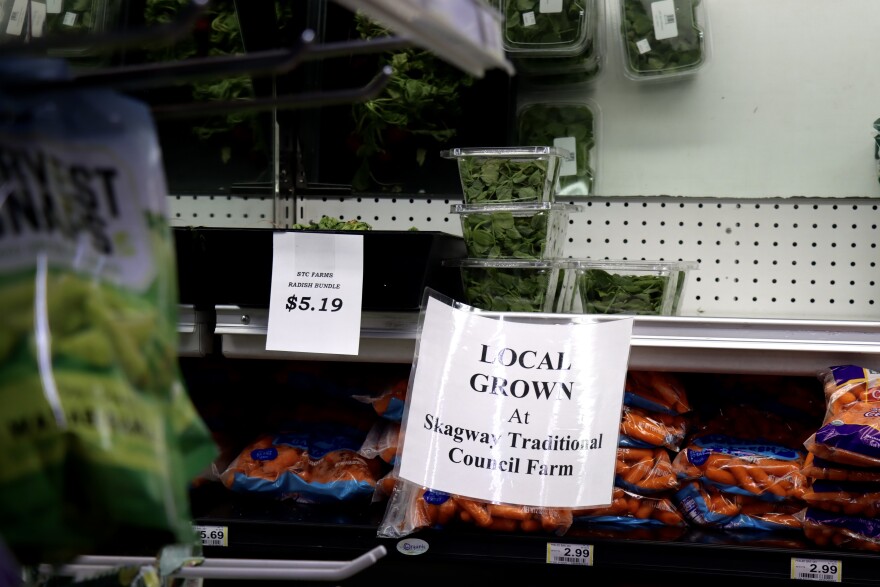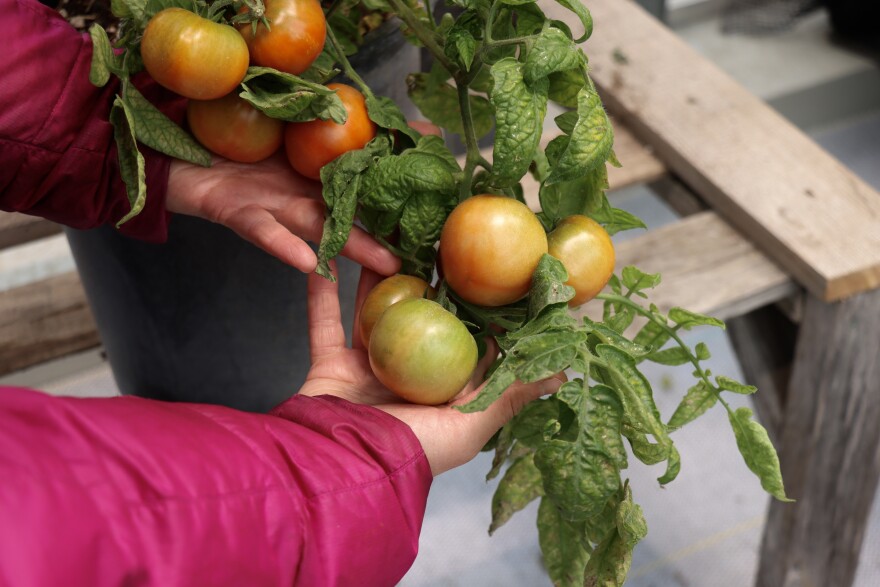This is the second story in a four-part series from the Alaska Desk called Shelf Life, which looks at food security in Alaska.
In the very back corner of Skagway’s only grocery store, a laminated sign boasts: “LOCAL GROWN.” Above it sits a container with bundles of radishes. Next to them, a few boxes of greens.
But that’s all there is. Everything else in the store is shipped in from very far away – and it shows. While walking the aisles of the AC Fairway Market earlier this month, resident Katie Auer picked up a bag of partially wilted and bruised mini peppers.
“You’re telling me I’m going to pay 9 dollars and 29 cents for a bag of peppers, that I’d have to throw away over half of them?” she said, shrugging.
Grocery chain Alaska Commercial Company bought the store in 2021 from long-time local owners. And Auer is among those who contend that the store is expensive, the shelves aren’t well stocked and the produce rots quickly.

Locals say that’s particularly true during summer – and that things are better in Haines, Skagway’s closest neighbor.
“Why is our produce so much more expensive?” Auer asked. “Why is our food in general so much more expensive than Haines, when it’s 13 extra nautical miles to get here? Why is it so much more rotten?”
A few factors drive those challenges, including shipping costs and the drastic seasonal population swings that come with hosting cruise ships in the summer.
Both make it harder to keep the store well stocked and profitable.
In response, some residents seem to be doing what they can to avoid the store entirely – including getting same-day grocery deliveries by small planes.
A catch-22
Skagway’s supermarket woes are not unique in Alaska, where communities across the state struggle to access affordable, fresh food.
But Skagway has some advantages other remote communities don’t. For starters, it’s connected to an international highway. And like much of Southeast, it’s on the barge route, which is perhaps the most efficient way to transport food.
“Certainly, within the data I see, as Southeast compares to the rest of the state and off-road Alaska, it’s a significantly lower quantity of food that actually spoils in transit to a store,” said Mike Jones, a food systems economist at the University of Alaska Anchorage.
But different communities face different challenges. In Skagway, they largely revolve around one main issue. The town’s wintertime population hovers around 900 people. Then, in the warmer months, it booms amid an influx of tourism workers and, on some days, more than 10,000 cruise ship passengers.

That sets the store up for a complicated guessing game: ordering, storing and stocking enough food to last through the week without shipping in so much that products rot in storage or on the shelves.
“In the summer, I don’t have enough space to maintain all the produce I could sell,” Lee McKinney, the Fairway manager, said. “But the other side of the coin is, if I do, a larger portion of that produce is going to go bad and have to be thrown out before I do sell it. It’s a catch-22.”
During the off-season, meanwhile, people complain that store shelves appear empty and that there are plenty of products the store doesn’t offer at all. Auer noted she prefers to drink skim milk, but that the store doesn’t carry it.
Brooke Jasky-Zuber, another local, said the store has limited organic products and few meat substitutes for her partner, who is vegetarian.
McKinney said he does what he can to meet folks’ needs, including ordering entire cases of certain products if a customer says they’ll buy all of it. But he added that he has to order specialty and more popular products based on what will actually sell.
“If I bring in that full shelf load, 90% of it’s going to date out before it sells and means I’ve got to write it off and throw it away,” he said.
“We got to make sure to make money with that space,” he added.

Quality and cost concerns
It’s less clear why the quality of food in Skagway would be worse than in Haines or Juneau. Jones, the food systems economist, said there could be a few factors at play.
He said stores could use different quality distributors. But they don’t. The Fairway in Skagway and the two Haines stores all use Rhode Island-based United Natural Foods Inc. for general grocery items. For produce, both the Fairway in Skagway and Olerud’s Market Center in Haines use a Seattle-based distributor called Charlie’s Produce.
Another factor could be the length of time food sits on the barge. But it doesn’t take that much longer for food to get to Skagway than it does to Haines or Juneau.
Product turnover could also help explain the problem. Consider a minimum shipment of lemons. It would likely take longer to sell those lemons in Skagway than in larger communities like Juneau or Haines.
“The big challenge is maintaining your product and not seeing everything date out on you because you don’t turn it fast enough,” McKinney said.

Then there’s the issue of prices, which fluctuate frequently and are determined by factors including freight costs, corporate pricing structures and more.
KHNS compared eight products at one store in Skagway to the same products at Howsers IGA Supermarket in Haines, including milk, various greens, and shelf-stable groceries. Everything was cheaper in Haines except spinach.
Jones, the economist, said that checks out.
“Skagway is on the high end within Southeast in terms of the prices that I can see for a couple products that happen to be right in front of me,” he said. “That’s not necessarily unreasonable, because they are farther up the barge away from Seattle.”

Grocery shopping by small plane
The challenges in Skagway underscore that even in communities with better access and infrastructure, struggles abound. And for some, the situation has reached a tipping point.
Auer, the Skagway local, said she hasn’t shopped at the Fairway in more than a year. Instead, she hits stores in Canada, Juneau and Haines when she can.
And she ships a lot of her food from out of town, including via Instacart — from Juneau.
Instacart is a service that allows people to order their groceries online and have someone pick them up at the store and deliver them to their doorstep.
In rural Alaska, it looks a little different. Customers can place their weekly orders from Skagway. Then, a driver in Juneau heads to Costco or Fred Meyer, shops, and delivers the food to the airport. From there, it’s loaded onto a flight and flown in – typically the same day.
“You can get two dozen free range organic eggs for $8 from Costco,” Auer said. “And they are $10.50 including shipping, including paying Instacart, tipping my driver and $1 per pound shipped here from Juneau.”
That day at the Fairway, there were two options for eggs: one cost $12 a dozen, the other about $9.

Flying food around southeast Alaska is far from new. But reliance on Instacart seems to be. Data provided by the company indicates that annual Instacart deliveries to the Juneau airport have more than doubled since 2019.
Jasky-Zuber is among those who said that relying on the local store to fill her fridge and pantry just doesn’t make sense any more. For the last four years, she’s managed the local tribe’s farm, which is where the locally grown radishes and greens in the store came from.
Jasky-Zuber said she sources most of her produce from the farm in the summertime. But otherwise, she stocks up on bulk items in Whitehorse, Canada – and ships plenty in from Juneau.
“Not because I don’t want to support our grocery store. I do,” Jasky-Zuber said. But ultimately, she added, “I find mostly other ways to get the bulk of what I need.”



